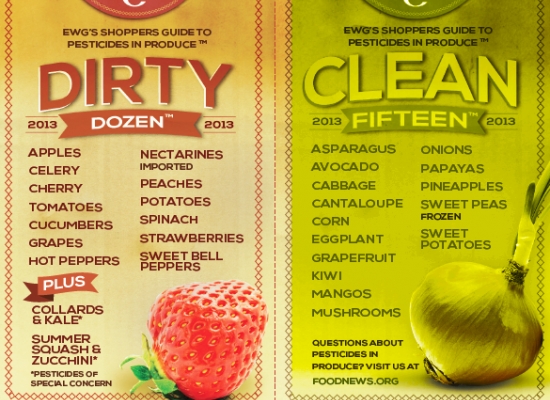The 2013 Dirty Dozen and Clean Fifteen Produce Guides

For the ninth year, the Environmental Working Group has released its popular Shopper’s Guide to Pesticides in Produce, which includes the Dirty Dozen and Clean Fifteen lists of the most and least pesticide contaminated fruits and vegetables.
As always, the samples tested by the EWG are thoroughly washed and peeled so that the areas being tested reflect what’s actually consumed. Forty-eight products are reviewed and ranked based on an analysis of more than 28,000 samples tested by the U.S. Department of Agriculture and federal Food and Drug Administration.
The best way to avoid pesticide-contaminated produce is to select organic fruit and vegetable options. “When given a choice, more consumers are choosing organic fruits and vegetables or using EWG’s Shopper’s Guide to find an easy affordable way to avoid toxic chemicals,” said Sonya Lunder, an EWG senior analyst. “They want to eat a diet rich in fruits and vegetables without eating too many pesticides. And they want to support local farms and agriculture that is better for the environment.”
But, the EWG also advises that eating a diet rich in fruits and vegetables, whether or not they’re organic, is more beneficial to consumers’ health than the risks associated with consuming the pesticide contaminated fruits and vegetables. Fruits and vegetables—organic or conventional—should always be washed thoroughly before consuming.
For the second year, the Dirty Dozen list also includes several added items in its “Plus” category, highlighting two crops: domestically grown summer squash and the extremely popular leafy green category of kale and collards. While these crops did not meet the traditional Dirty Dozen criteria, they did test positive for contamination with pesticides that can be particularly damaging to the nervous system. And with the growing kale-obsession taking over our nation, it’s important to consider organic options whenever possible.
The Clean Fifteen list focuses on the conventionally grown crops with the least amount of pesticide residue (yes, there are some safe ones out there!), giving consumers safer options when selecting non-organic fruits and vegetables. It’s also a great resource for sub-ins of items on the Dirty Dozen. Can’t find organic apples? Have a conventional cantaloupe or kiwi instead. No organic potatoes? How about non-organic sweet potatoes?
Consumers who routinely shop at farmers markets can also talk with their farmers directly about the use of pesticides on their crops. With organic certification a costly procedure, many non-organic growers are actually using organic methods.
The Dirty Dozen Plus
1. Apples
2. Celery
3. Cherry Tomatoes
4. Cucumbers
5. Grapes
6. Hot Peppers
7. Nectarines (imported)
8. Peaches
9. Potatoes
10. Spinach
11. Strawberries
12. Sweet Bell Peppers
Plus:
13. Kale and Collard Greens
14. Summer Squash
The Clean Fifteen
1. Asparagus
2. Avocados
3. Cabbage
4. Cantaloupe
5. Sweet Corn
6. Eggplant
7. Grapefruit
8. Kiwi
9. Mangos
10. Mushrooms
11. Onions
12. Papayas
13. Pineapples
14. Sweet Peas (frozen)
15. Sweet Potatoes
To read the full report, go here.